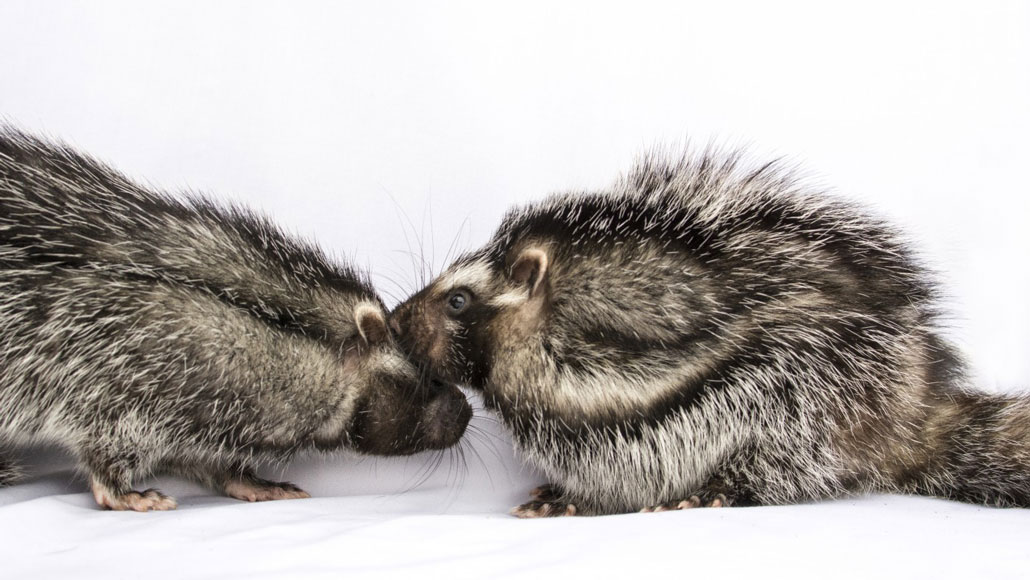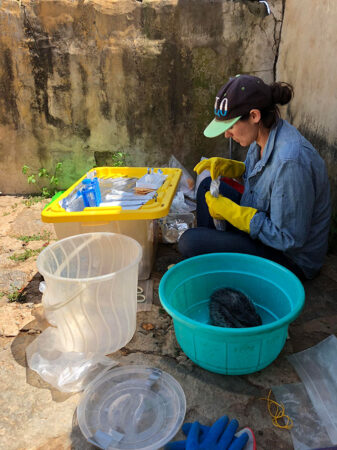Africa’s poisonous rats are surprisingly social
These rare rodents may live in pairs, or even family groups

Two African crested rats interact with each other.
Stephanie Higgins
Share this:
- Share via email (Opens in new window) Email
- Click to share on Facebook (Opens in new window) Facebook
- Click to share on X (Opens in new window) X
- Click to share on Pinterest (Opens in new window) Pinterest
- Click to share on Reddit (Opens in new window) Reddit
- Share to Google Classroom (Opens in new window) Google Classroom
- Click to print (Opens in new window) Print
African crested rats — fluffy, rabbit-sized furballs from East Africa — are finally starting to reveal their secrets. In 2011, scientists discovered that the rats lace their fur with a deadly poison. Now researchers report that these animals are surprisingly friendly toward each other, and may even live in family groups.
Sara Weinstein is a biologist who studies mammals at the University of Utah in Salt Lake City. She also works with the Smithsonian Conservation Biology Institute in Washington, D.C. She was studying the poisonous rats but initially wasn’t focused on their behavior. “The original goal was to look into the genetics,” she says. She wanted to understand how the rats were able to apply poison to their fur without becoming sick.
The rats chew leaves and bark from the poison arrow tree and apply their now-toxic spit to their hair. The tree contains a class of chemicals called cardenolides that are very toxic to most animals. “If we were to sit there and chew on one of these branches, we would certainly not be going about our normal activities,” Weinstein says. A person would probably throw up. And if someone consumed enough of the poison, their heart would stop beating.
But scientists didn’t know how common this behavior was in the rats; the 2011 report focused on just one animal. They also didn’t know how the rats could safely chew the poisonous plant. The rats were “kind of like a myth,” says Katrina Malanga. A co-author of the study, she’s a conservationist at Oxford Brookes University in England.
The rat house
To study the rats, the research team set up cameras to capture images of the nocturnal animals. But in 441 nights, the rats tripped the cameras’ motion detectors only four times. The rats are probably too small and slow to set off the camera, Weinstein says.

Trapping the rats might work better, the researchers decided. This way, they could study the rodents in a captive setting. The scientists laced traps with a smelly mixture that included peanut butter, sardines and bananas. And they worked. In all, the team managed to capture 25 rats, two of which were caught in one trap, as a pair.
The scientists placed several of the animals in a “rat house,” a small cow shed with video cameras inside. This apartment-style shed allowed the researchers to keep the rats in separate spaces. The team observed what happened when the rats were kept apart and what happened when two or three rats were placed in the same apartment. In the 432 hours of rat videos with multiple rats in one space, the researchers could see how the rats interacted.
At times, the animals would groom each other’s fur. And while “they occasionally get into little rat tiffs,” these fights didn’t last too long, Weinstein says. “They don’t seem to hold on to grudges.” Sometimes, male and female rats formed a pair. These paired rats often stayed within 15 centimeters (6 inches) of one another. They would also follow each other throughout the “rat house.” More than half the time, the female would lead the way. A few of the adult rats also took care of young rats, cuddling with them and grooming them. The researchers think that these behaviors indicate that the animals might live in pairs that raise their young, as a family group.
Weinstein and her colleagues described the rats’ social lives in the November 17 Journal of Mammalogy.
Questions remain
Darcy Ogada is a biologist living in Kenya. She works with the Peregrine Fund. It’s a group based in Boise, Idaho, that is dedicated to protecting birds. A few years ago, she studied owls that eat the rats. She concluded that the rats are really rare. One owl might eat and poop out only five rats a year, she reported in 2018. That suggests that there was only one rat for every square kilometer (0.4 square mile) of land. She figured the rats were solitary and lived alone. So the new findings are surprising, she notes.
“There are so few things that are left, that are not known to science,” Ogada says, but these rats are one of those mysteries. This new study gives a good look into the lives of the rats, she says, although scientists are still only scratching the surface. Many questions remain.
That includes how the rats avoid getting sick from the poison, the original focus of Weinstein’s research. But the study did confirm the rats’ behavior. And it showed the rats didn’t get poisoned. “We were able to watch them chew and apply the plant and then watch their behavior afterwards,” Weinstein says. “What we found is that it actually had no effect on their amount of movement or feeding behavior.”
Watching this behavior was one of the coolest parts of the research, says Malanga. The researchers knew that even a tiny bit of the poison could bring down large animals. But the rats seemed totally fine. “Once we saw that with our own eyes,” she says, “we’re like, ‘This animal is not dying!’”
The researchers are hoping to learn more about the poison in the future. And there’s still more to learn about the rats’ social lives, Weinstein says. For example, do they help each other apply poison? And how do they even know which plants to go to for the poison?







